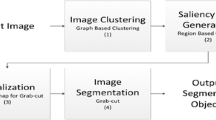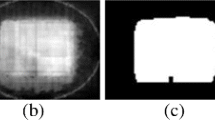Abstract
A new method for automatic salient object segmentation is presented. Salient object segmentation is an important research area in the field of object recognition, image retrieval, image editing, scene reconstruction, and 2D/3D conversion. In this work, salient object segmentation is performed using saliency map and color segmentation. Edge, color and intensity feature are extracted from mean shift segmentation (MSS) image, and saliency map is created using these features. First average saliency per segment image is calculated using the color information from MSS image and generated saliency map. Then, second average saliency per segment image is calculated by applying same procedure for the first image to the thresholding, labeling, and hole-filling applied image. Thresholding, labeling and hole-filling are applied to the mean image of the generated two images to get the final salient object segmentation. The effectiveness of proposed method is proved by showing 80%, 89% and 80% of precision, recall and F-measure values from the generated salient object segmentation image and ground truth image.
Similar content being viewed by others
References
JUNG Chan-ho, KIM Cahn-gick. A unified spectral-domain approach for saliency detection and its application to automatic object segmentation [J]. IEEE Transactions on Image Processing, 2012, 21(3): 1272–1283.
HAN Sung-ho, HONG Yeong-pyo, LEE Sang-hun. Applying differential techniques for 2D/3D video conversion to the objects grouped by depth information [J]. Journal of The Korea Academia-Industrial Cooperation Society, 2012, 13(3): 1302–1309.
LI Hong-liang, NGAN N. Saliency model-based face segmentation and tracking in head-and-shoulder video sequences [J]. Journal of Visual Communication and Image Representation, 2008, 19(5): 320–333.
AVRAHAM T, LINDENBAUM M. Esaliency (extended saliency): Meaningful attention using stochastic image modeling [J]. IEEE Transactions on Pattern Analysis and Machine Intelligence, 2010, 32(4): 693–708.
GUO Chen-lei, ZHANG Li-ming. A novel multiresolution spatiotemporal saliency detection model and its applications in image and video compression [J]. IEEE Transactions on Image Processing, 2010, 19(1): 185–198.
ITTI L, KOCH C, NIEBUR E. A model of saliency-based visual attention for rapid scene analysis [J]. IEEE Transactions on Pattern Analysis and Machine Intelligence, 1998, 20(11): 1254–1259.
MA Yu-fei, ZHANG Hong-jiang, Contrast-based image attention analysis by using fuzzy growing [C]// ACM International Conference on Multimedia. New York: ACM, 2003: 374–381.
OUERHANI N, BUR A, HÜGLI H. Linear vs. nonlinear Feature Combination for Saliency Computation: A comparison with human Vision [J]. Lecture Notes in Computer Science, 2006, 4174: 314–323.
HAREL J, KOCH C, PERONA P. Graph-Based Visual Saliency [J]. Advances in Neural Information Processing Systems, 2007, 19: 545–552.
HOU Xiao-di, ZHANG Li-qing. Saliency detection: A spectral residual approach [C]// IEEE Conference on Computer Vision and Pattern Recognition. Minneapolis: IEEE Press, 2007: 1–8.
HU Yi-qun, XIE Xing, MA Wei-ying, CHIA Liang-tien, RAJAN D. Salient region detection using weighted feature maps based on the human visual attention model [J]. Lecture Notes in Computer Science, 2005, 3332: 993–1000.
ACHANTA R, HEMAMI S, ESTRADA F, SÜSSTRUNK S. Frequency-tuned salient region detection [C]// IEEE Conference on Computer Vision and Pattern Recognition. Miami: IEEE Press, 2009: 1597–1604.
LIANG Zhuo-jia, WANG Ming-jia, ZHOU Xiao-cong. Salient object detection based on regions [J]. Multimedia Tools and Applications, 2012, DOI: 10.1007/s11042-012-1040-1.
CHENG Ming-ming, ZHANG Guo-xin, MITRA NILOY J, HUANG Xiao-lei, HU Shi-min. Global contrast based salient region detection [C]// IEEE Conference on Computer Vision and Pattern Recognition, 2011: 409–416.
MARCHESOTTI L, CIFARELLI C. Gabriela csurka, a framework for visual saliency detection with applications to image thumbnailing [C]// IEEE International Conference on Compter Vision. Kyoto: IEEE Press, 2009: 2232–2239.
LIU Zhi, SHI Ran, SHEN Li-quan, XUE Yin-zhu, NGAN K N, ZHANG Zhao-yang. Unsupervised salienct object segmentation based on kernel density estimation and two-phase graph cut [J]. IEEE Transactions on Multimedia, 2012, 14(4): 1275–1289.
LIU Tie, SUN Jian, ZHENG Nan-ning, TANG Xiao-ou, SHUM Heung-yeung. Learning to detect a salient object [C]// IEEE Conference on Computer Vision and Pattern Recognition. Minneapolis: IEEE Press, 2007: 1–8.
HAN SUNG-HO, HONG YEONG-PYO, LEE SANG-HUN. Saliency map creation method robust to the contour of objects [J]. The Korea Society of Digital Policy & Management, 2012, 10(3): 173–178
ACHANTA R, ESTRADA F, WILS P, SÜSSTRUNK S. Salient Region Detection and Segmentation [C]// Proceedings of 6th International Conference in Computer Vision System, Santorini, Greece: ICVS, 2008: 66–75.
Author information
Authors and Affiliations
Corresponding author
Rights and permissions
About this article
Cite this article
Han, Sh., Jung, Gd., Lee, Sy. et al. Automatic salient object segmentation using saliency map and color segmentation. J. Cent. South Univ. 20, 2407–2413 (2013). https://doi.org/10.1007/s11771-013-1750-1
Received:
Accepted:
Published:
Issue Date:
DOI: https://doi.org/10.1007/s11771-013-1750-1




